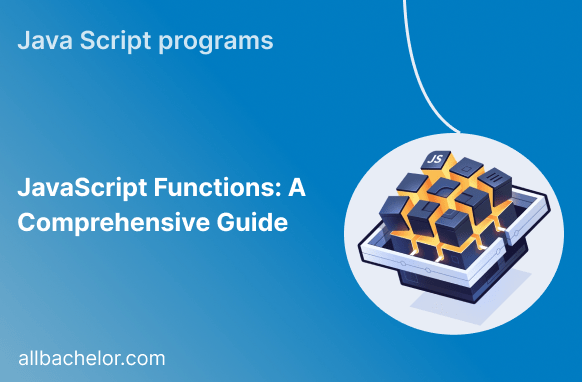JavaScript functions are a fundamental component of the language, designed to simplify complex tasks by breaking them down into smaller, more manageable parts. In this blog post, we’ll provide you with user-friendly guidance on everything you need to know about using JavaScript functions effectively.
What are JavaScript functions?
A JavaScript function is a block of code that performs a specific task. It is executed when it is called or invoked by something in your program. Functions are fundamental components of JavaScript that allow you to write reusable code, which can be used from multiple parts of your program. This reusability helps make your code more efficient and organized.
What are the different types of JavaScript functions?
There are two types of functions in JavaScript: named functions and anonymous functions.
A named function is a function that has a name. For example:
function myFunction() {
// code to be executed
}An anonymous function is a function that does not have a name. For example:
var myFunction = function() {
// code to be executed
};How to create a JavaScript function?
You can create a JavaScript function using the `function` keyword followed by the name of the function and parentheses. For example:
function myFunction() {
// code to be executed
}You can also define parameters for your function by listing them inside the parentheses. For example:
function addNumbers(num1, num2) {
return num1 + num2;
}How to call a JavaScript function?
You can call a JavaScript function by using its name followed by parentheses. For example:
myFunction();If your function takes parameters, you can pass them inside the parentheses. For example:
addNumbers(5, 10);What are the parameters and arguments of a JavaScript function?
Parameters are the names listed in the function definition. Arguments are the values passed to the function when it is called. For example:
function myFunction(param1, param2) {
// code to be executed
}
myFunction(arg1, arg2);In this example, `param1` and `param2` are parameters, while `arg1` and `arg2` are arguments.
What are the return values of a JavaScript function?
A JavaScript function can return a value using the `return` keyword. For example:
function myFunction() {
return "Hello World!";
}You can also return variables or expressions. For example:
function addNumbers(num1, num2) {
var sum = num1 + num2;
return sum;
}What are the scope rules of JavaScript functions?
In JavaScript, when you declare variables within a function, they have a local scope, meaning they are only accessible within that specific function. On the other hand, variables declared outside of any function have a global scope, which allows them to be accessed from any part of the program. Therefore, if you declare a variable inside a function, you cannot access it outside of that function.
What are the benefits of using JavaScript functions?
JavaScript functions offer modularity and enhance code reusability. They enable you to divide intricate tasks into smaller, more manageable components. This approach not only improves code organization but also makes it easier to comprehend and maintain.
By decomposing your code into smaller functions, you enhance its readability. Each function encapsulates a specific functionality, making it simpler to grasp the purpose of individual sections within your program. Consequently, this enhances code maintainability, as modifications or bug fixes can be targeted to specific functions rather than the entire program.
How to debug JavaScript functions?
Debugging your JavaScript functions is an important part of writing good code. There are several ways to debug your functions:
- Use console.log() statements to output information about your variables and program flow.
- Use breakpoints in your browser’s developer tools.
- Use automated testing frameworks like Jest or Mocha.
What are the best practices for writing JavaScript functions?
Some best practices for writing JavaScript functions include:
- Keeping your functions short and focused on one task.
- Using descriptive names for your functions.
- Using comments to explain what your functions do.
- Avoiding global variables inside your functions.
By following these best practices, you can make your code more readable and easier to maintain.
How to make your JavaScript functions more efficient?
Making your JavaScript functions more efficient is an important part of writing good code. Some ways to make your functions more efficient include:
- Avoiding unnecessary calculations or loops.
- Using built-in methods instead of writing your own.
- Minimizing DOM manipulation.
- Caching frequently used values.
By making your code more efficient, you can improve its performance and reduce its memory usage.
How to test your JavaScript functions?
Evaluating JavaScript functions through automated testing frameworks such as Jest or Mocha is a crucial aspect of developing high-quality code. These frameworks enable you to create test cases that compare the results of your functions with predetermined values. This process aids in identifying and addressing potential bugs and mistakes before they affect the final product.
How to document your JavaScript functions?
When writing JavaScript code, it’s crucial to document your functions properly. One way to do this is by using JSDoc comments, which are special comments starting with `/**` and ending with `*/`. These comments enable you to describe the parameters, return values, and purpose of your functions. By documenting your code in this way, you can improve its readability and make it easier for others (including yourself) to understand and maintain the code in the future.
Here’s an example:
/**
* Adds two numbers together.
* @param {number} num1 - The first number.
* @param {number} num2 - The second number.
* @returns {number} The sum of num1 and num2.
*/
function add(num1, num2) {
return num1 + num2;
}How to share your JavaScript functions with others?
Sharing your JavaScript functions with others is a crucial aspect of being a developer. To achieve this, you have the option of publishing your functions on platforms like NPM or GitHub.
NPM serves as a package manager specifically designed for Node.js, enabling you to distribute your code to fellow developers. On the other hand, GitHub is a web-based platform that offers version control and collaboration features, empowering you to share your code openly with the global community.
Conclusion
JavaScript functions play a vital role in the language, enabling the division of intricate tasks into smaller, more manageable segments. Our comprehensive blog post encompasses all the necessary information about JavaScript functions, encompassing their definition, creation, and effective utilization. Additionally, we delve into recommended approaches for crafting JavaScript functions, debugging them, and performing tests. By adhering to these guidelines and suggestions, you can produce superior JavaScript code that is both efficient and easily comprehensible, promoting code maintenance.



